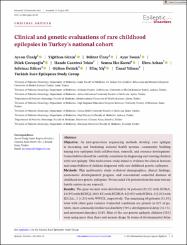| dc.contributor.author | Ünalp, Aycan | |
| dc.contributor.author | Güzin, Yiğithan | |
| dc.contributor.author | Ünay, Bülent | |
| dc.contributor.author | Tosun, Ayşe | |
| dc.contributor.author | Çavuşoğlu, Dilek | |
| dc.contributor.author | Gazeteci Tekin, Hande | |
| dc.contributor.author | Hız Kurul, Semra | |
| dc.contributor.author | Arhan, Ebru | |
| dc.contributor.author | Edizer, Selvinaz | |
| dc.contributor.author | Öztürk, Gülten | |
| dc.contributor.author | Yiş, Uluç | |
| dc.contributor.author | Yılmaz, Ünsal | |
| dc.contributor.author | Türk Nadir Epilepsiler Çalışma Grubu | |
| dc.date.accessioned | 2023-10-12T10:37:59Z | |
| dc.date.available | 2023-10-12T10:37:59Z | |
| dc.date.issued | 2023 | en_US |
| dc.identifier.citation | Ünalp, A., Güzin, Y., Ünay, B., Tosun, A., Çavuşoğlu, D., Tekin, H. G., ... & Turkish Rare Epilepsies Study Group. (2023). Clinical and genetic evaluations of rare childhood epilepsies in Turkey's national cohort. Epileptic Disorders. | en_US |
| dc.identifier.issn | 1950-6945 | |
| dc.identifier.uri | https://dx.doi.org/10.1002/epd2.20150. | |
| dc.identifier.uri | https://hdl.handle.net/20.500.12933/1637 | |
| dc.description.abstract | Abstract
Objective: As new-generation sequencing methods develop, rare epilepsy is increasing and burdening national health systems-community building among rare epilepsies fuels collaboration, research, and resource development. Comorbidities should be carefully considered in diagnosing and treating children with rare epilepsy. This multicentric study aimed to evaluate the clinical features and comorbidities of children diagnosed with rare childhood genetic epilepsies.
Methods: This multicentric study evaluated demographics, clinical findings, neuromotor developmental progress, and concomitant comorbid diseases of childhood rare genetic epilepsies. We included 156 patients from the nine tertiary health centers in our research.
Results: The gene variants were distributed to 36 patients (23.1%) with SCN1A, 14 (9%) with KCNQ2, 10 (6.4%) with PCDH19, 6 (3.8%) with SCN8A, 5 (3.2%) with SLC2A1, 5 (3.2%) with WWOX, respectively. The remaining 80 patients (51.3%) were with other gene variants. Comorbid conditions are present in 82% of patients, most commonly intellectual disability (70%), developmental delay (32.1%), and movement disorders 12.8%. Most of the rare genetic epileptic children (52%) were using more than three anti-seizure drugs. In terms of developmental delay in children with rare epilepsy, the neuromotor developmental delay was found to progress with age, shown at the end of 2nd year of treatment. In addition, comorbidity, number of drugs, multiple types of seizures, seizure frequency, age at diagnosis of epilepsy, and duration of epilepsy all affected neuromotor developmental status (p < .05).
Significance: Despite using multiple antiseizure medications, most of our patients had drug-resistant epilepsy and concomitant developmental delay. Since a complete cure cannot be achieved in most of these patients further studies with centers' collaboration might help improve therapeutic decisions and precision treatment methods. | en_US |
| dc.language.iso | en | |
| dc.publisher | [Hoboken] | en_US |
| dc.relation.ispartof | Epileptic disorders : international epilepsy journal with videotape | |
| dc.rights | info:eu-repo/semantics/embargoedAccess | en_US |
| dc.subject | Childhood | en_US |
| dc.subject | Comorbidity | en_US |
| dc.subject | Genetic | en_US |
| dc.subject | Precision Medicine | en_US |
| dc.subject | Rare Epilepsy | en_US |
| dc.title | Clinical and genetic evaluations of rare childhood epilepsies in Turkey's national cohort | en_US |
| dc.type | Article | |
| dc.identifier.orcid | 0000-0003-4924-5300 | en_US |
| dc.department | AFSÜ | en_US |
| dc.institutionauthor | Çavuşoğlu, Dilek | |
| dc.identifier.doi | 10.1002/epd2.20150 | |
| dc.relation.publicationcategory | Makale - Uluslararası Hakemli Dergi - Kurum Öğretim Elemanı | en_US |
| dc.identifier.pmid | 37584621 | |
| dc.identifier.wos | WOS:001052434100001 | |
| dc.identifier.wosquality | Q3 | |
| dc.indekslendigikaynak | Web of Science | |
| dc.indekslendigikaynak | PubMed | |
















